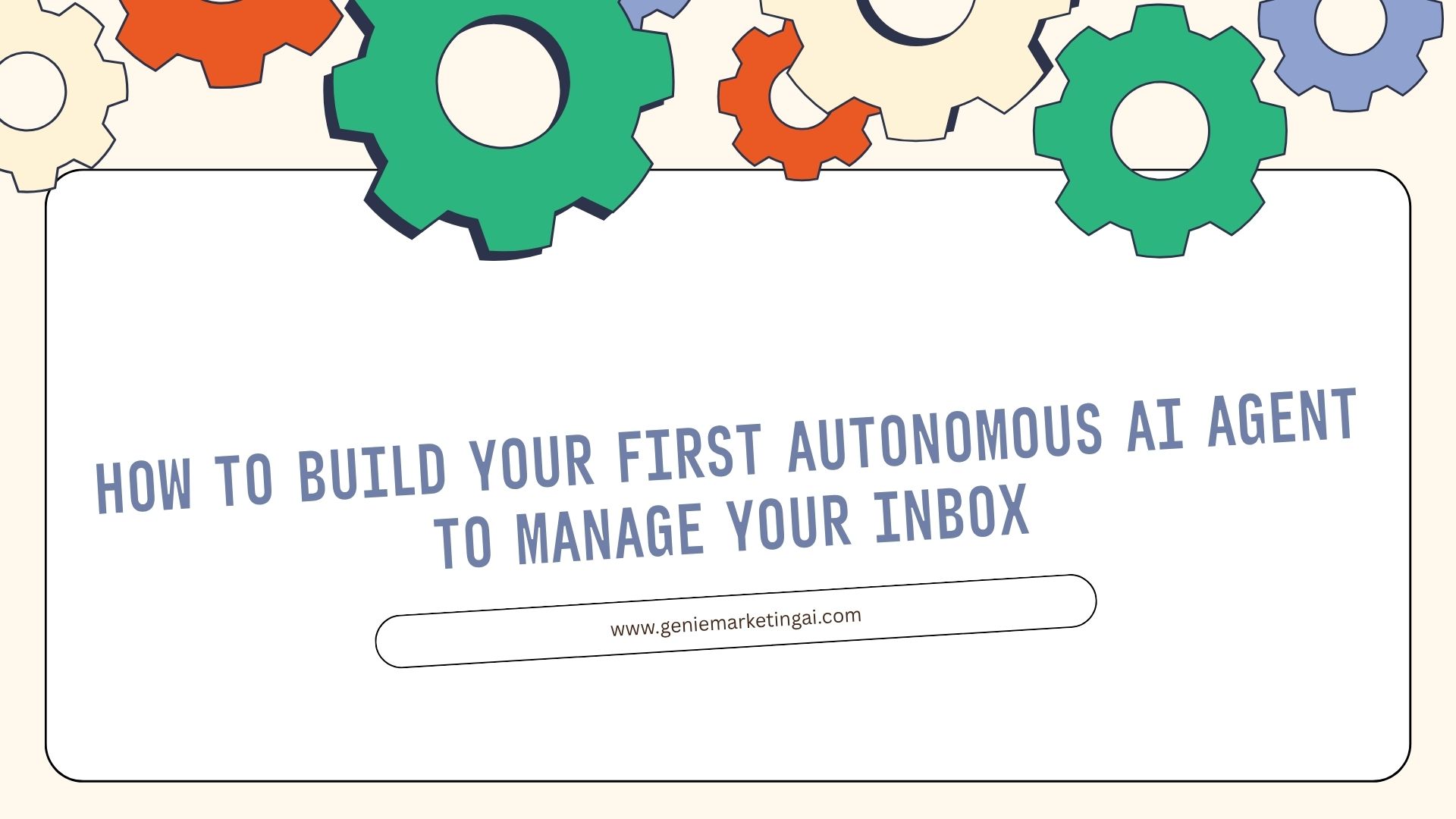Does opening your email feel like standing in front of a tidal wave? If you nod yes, you’re not alone. Every day, a flood of newsletters, notifications, meeting requests, and actual important messages pours in. Studies show that the average professional spends nearly three hours a day on email, and the mental weight of a constantly full inbox can be draining.
But what if you had a smart, tireless assistant working for you 24/7, right inside your inbox? An assistant that never gets tired, never needs a coffee break, and actually learns to think like you?
Welcome to the world of autonomous AI agents. These aren’t just simple tools; they are your personal digital employees. By the end of this guide, you will understand exactly what these agents are and how you can build your very first one to bring order to your email chaos—no coding required!
So, What’s an AI Agent Anyway?
You’ve probably used AI like ChatGPT, where you type a prompt and get a response. That’s like having a conversation with a super-smart encyclopedia. An AI agent, however, is different.
An AI agent is a program you give a goal to, and it works on its own to achieve it. It makes decisions and takes actions without you needing to tell it what to do every step of the way.
Think of it like this:
- ChatGPT: You ask it, “Please write a reply to this email.”
- AI Agent: You tell it, “Your job is to manage my inbox. For any email that looks like a customer complaint, draft a polite apology and flag it for my review.”
The agent then watches your inbox continuously and does its job autonomously. This is perfect for email because the flood never stops, and an agent can filter, sort, and act on messages the second they arrive.
An email agent can learn to:
- Triage and Prioritize: Like an emergency room doctor, it can instantly tell which emails are urgent and which can wait.
- Draft Replies: It can handle routine responses, saving you hours of typing.
- Extract Tasks: It can spot action items (like “Can you send the file by Friday?”) and add them to your to-do list automatically.
- Learn and Adapt: The more you use it, the smarter it gets.
The Building Blocks of Your Email AI Agent
To build our email assistant, we need a few key parts that work together. Think of it like a recipe with five main ingredients.
- Email Connection: This is how your agent gets access to your inbox. It uses something called an API—think of it as a secure, special key that lets your agent read incoming emails and send replies on your behalf without ever needing your password.
- The “Brain” (NLP Module): This is the part that understands human language. It reads the email’s content, figures out the sender’s tone (are they happy, angry?), and identifies what the email is about.
- The “Rulebook” (Decision-Making Logic): This is the boss of the operation. After the brain understands an email, the rulebook decides what to do next. For example: “IF the email is a newsletter, THEN move it to the ‘Read Later’ folder.”
- The “Hands” (Action Module): This is the part that does the actual work. It can label emails, archive them, draft a reply, add an event to your calendar, or create a task in an app like Notion or Asana.
- The “Feedback Loop” (Learning): This is how your agent gets smarter. When it makes a mistake and you correct it (e.g., you move an email it labeled “Urgent” to “Spam”), it learns from that feedback to do a better job next time.
Step-by-Step Guide: Building Your Agent (The No-Code Way!)
Ready to build? You don’t need to be a programmer! We’ll use modern no-code platforms that feel like putting together LEGO bricks.
Step 1: Choose Your Playground
There are many fantastic tools available in 2025 that let you build AI agents with a visual, drag-and-drop interface. Here are a few popular choices:
- Zapier Agents: Great for beginners and connecting thousands of different apps.
- n8n: A powerful and often free option for visual workflow automation.
- MindStudio: A platform specifically designed for building various types of AI applications visually.
- Microsoft Copilot Studio: The perfect choice if you live in the Outlook and Microsoft ecosystem.
For this guide, the logic will be similar no matter which platform you choose.
Step 2: Define Your Agent’s First Job
Start simple. Don’t try to make your agent do everything at once. A perfect first goal is: Automatically categorize and label incoming emails.
Step 3: Connect Your Email Account
This is the first step on any platform. You’ll be prompted to connect your Gmail, Outlook, or other email account. You’ll go through a secure sign-in process called OAuth, which gives the platform permission to act as your agent.
Step 4: Design the Workflow (Our Example: The Categorizer)
Now for the fun part! Let’s build the logic. In your chosen platform, you’ll create a new workflow that looks something like this:
1. The Trigger: “New Email Received” This is the starting block. The workflow will automatically run every time a new email hits your inbox.
2. The First Action: “Analyze with AI” Drag an AI node (powered by a model like GPT-4) into your workflow. You’ll give the AI a clear prompt. This is where a little bit of prompt engineering is still useful!
- Your Prompt: “You are an expert email assistant. Read the following email content and categorize it into one of these four labels: Urgent, Newsletter, Question, or Junk. Provide only the label as your response.”
3. The Logic: “If/Then” Now you’ll use conditional logic—simple “if/then” rules—to tell the agent what to do based on the AI’s response.
- IF the AI’s output is
Urgent:- THEN apply the “Urgent” label in Gmail/Outlook.
- AND send me a notification on my phone.
- IF the AI’s output is
Newsletter:- THEN apply the “Newsletter” label.
- AND automatically archive it so it doesn’t clutter my main inbox.
- IF the AI’s output is
Question:- THEN star the email and apply the “Needs Reply” label.
- IF the AI’s output is
Junk:- THEN move the email to the Spam folder.
Step 5: Test and Refine
Send yourself a few test emails of different types. See how your agent categorizes them. Did it get one wrong? Go back and tweak your AI prompt to be more specific. Building an agent is a process of testing and improving.
Level Up: Advanced Features for Your Agent
Once your agent is expertly sorting your mail, you can add more powerful skills:
- Automated Response Drafting: Create a workflow where if an email is a
Questionabout a common topic, the agent drafts a reply based on a template. You can set it up so it saves the reply as a draft for you to approve with one click. - Meeting Scheduling: If an email contains a meeting request, your agent can be taught to check your Google or Outlook Calendar and automatically suggest three open time slots.
- Summarizing Long Threads: Add a step that says, “If an email thread has more than 5 replies, use AI to create a 3-bullet-point summary of the entire conversation and send it to me.”
Best Practices: Staying Safe and Smart
- Start Small, Iterate Big: Master one task before adding another. A simple, reliable agent is better than a complex, broken one.
- Mind Your Privacy: Use trusted, well-known platforms. Be aware of how they handle your data. Never give access to platforms you don’t trust.
- You Are the Pilot: Your agent is a powerful co-pilot, but you are always in charge. For important actions, like deleting emails or sending replies, keep a human approval step in the loop until you are completely confident in its abilities.
The Future of Your Inbox
Building your first agent is just the beginning. Soon, you’ll have an ecosystem of agents working for you. Your email agent will talk to your travel agent, which will talk to your finance agent, creating a seamless, automated personal management system. These agents will become deeply personalized, anticipating your needs before you even express them.
Conclusion: Your Inbox, Reimagined
Email overload doesn’t have to be a fact of life. By building your own autonomous AI agent, you can transform your inbox from a source of stress into a streamlined, intelligent hub that works for you, not against you. You now have the blueprint to get started.
So, what are you waiting for? Pick a platform, choose that first simple task, and build your inbox’s new best friend today.



1 thought on “How to Build Your First Autonomous AI Agent to Manage Your Inbox”